Thinking about going green for your commute? Wondering if solar panels can juice up your electric vehicle? Absolutely, you can – it’s a sustainable choice for both your wallet and the environment!
Solar panels can indeed be used to charge electric vehicles. Simply put, solar panels absorb sunlight and convert it into electricity. This electricity, then, can be utilized to charge the battery of your electric vehicle.
Photovoltaic solar panels capture sunlight and convert it into direct current (DC). An inverter then transforms this DC into alternating current (AC), the form of electricity your electric vehicle charger can use.
Extra electricity generated during the day can be stored in a home battery system for use in the absence of sunlight. This ensures you can charge your electric vehicle any time.

However, charging your electric vehicle directly from solar panels requires a specific solar car charger. These are designed to maximize solar power utilization and can usually be installed wherever you typically park your electric vehicle.
Can solar panels generate enough power to charge my electric vehicle?
Solar panels can definitely generate enough power to charge your electric vehicle (EV), provided your system is designed to meet your specific needs.
However, the number of solar panels required and the time it would take to charge your electric vehicle can vary widely. This depends on factors such as the size and efficiency of your solar panels, the amount of sunlight your area receives, and the capacity of your electric vehicle’s battery.
Let’s take a practical example to illustrate this point. Assume that you have a Tesla Model 3, one of the most popular electric vehicles on the market. The long-range version of this vehicle has a battery capacity of 75 kWh (kilowatt-hours) and can travel about 322 miles on a full charge. If you drive an average of 30 miles per day, you’d use around 7 kWh of electricity daily.
Next, let’s consider your solar panels. On average, a single solar panel of around 300 watts can produce about 1.2 kWh of electricity per day, assuming 4 hours of peak sunlight.
To generate the 7 kWh needed to cover your daily driving, you’d need about 6 of these solar panels.
However, it’s worth noting that this is a simplified example and actual figures may vary. Factors such as panel orientation, shading, weather conditions, and even the time of year can all affect the amount of electricity your solar panels produce.
Furthermore, the efficiency of your inverter and any potential energy loss during the conversion from DC to AC power can also influence how effectively your panels can charge your electric vehicle.
The above example doesn’t take into account the use of a battery storage system either.
But what about batteries?
If you choose to install a battery to store your solar energy, you could continue charging your electric vehicle even when the sun isn’t shining. However, this would require additional investment and could impact the overall efficiency of your system.
Overall, while solar panels can certainly generate enough power to charge an electric vehicle, setting up an efficient and effective system requires careful planning and consideration of your specific circumstances and needs. Consulting with a solar energy professional can be a great way to ensure you’re getting the most out of your solar-powered electric vehicle charging setup.
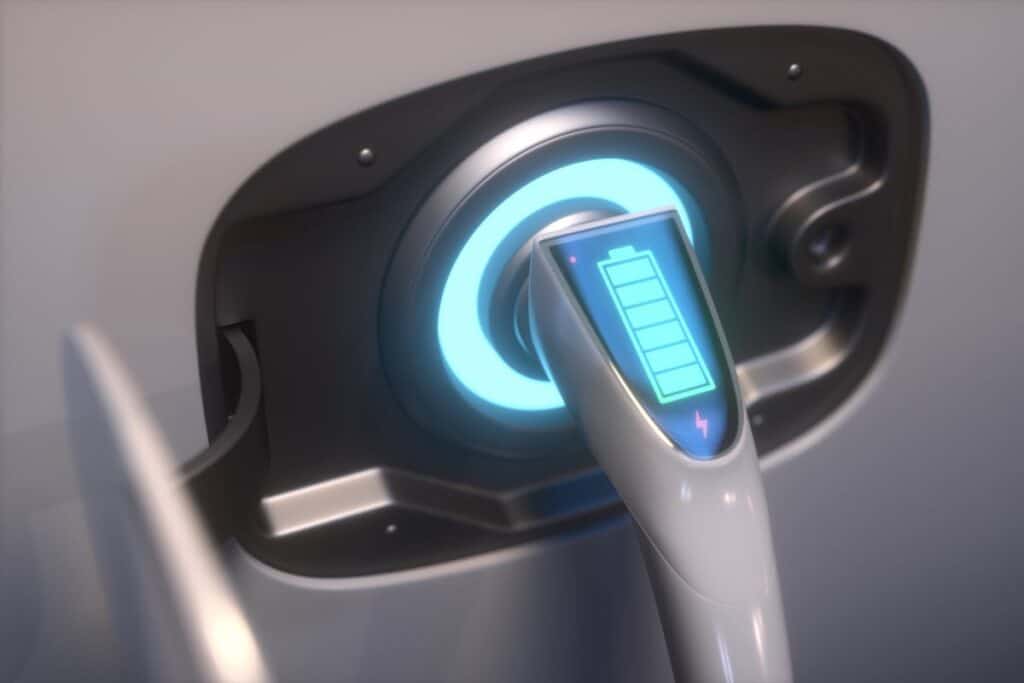
How long will it take to charge my electric vehicle using solar power?
Charging an electric vehicle with solar power is an excellent example of sustainable living. However, the time it takes to charge your electric vehicle using solar panels can vary greatly, depending on a few key factors: the capacity of your electric vehicle’s battery, the power output of your solar panel system, and the amount of sunlight exposure your panels receive.
As an example, let’s continue using a Tesla Model 3 with a 75 kWh battery from the previous section.
We’ll pair this with a solar panel system consisting of six 300-watt panels, which is capable of generating around 7.2 kWh of electricity daily, assuming 4 hours of peak sunlight.
If your electric vehicle’s battery was entirely depleted, charging it to full capacity using solar power would theoretically take a little over 10 days (75 kWh ÷ 7.2 kWh/day).
However, considering that most electric vehicle drivers typically don’t fully deplete their batteries before recharging, the actual charging time in practice would generally be much shorter.
Bear in mind that this is a simplified estimation. Many factors can influence how quickly your solar panels can charge your electric vehicle.
It’s not just about the number of solar panels…
The amount and intensity of sunlight your solar panels receive can vary depending on your geographic location, the time of year, and daily weather conditions.
Furthermore, the orientation and tilt of your solar panels can also impact their performance.
Also, you should consider the use of a home energy storage system, such as a Tesla Powerwall.
If you generate more solar energy than you use during the day, this excess power can be stored in the battery and used to charge your electric vehicle overnight or during periods of low sunlight.
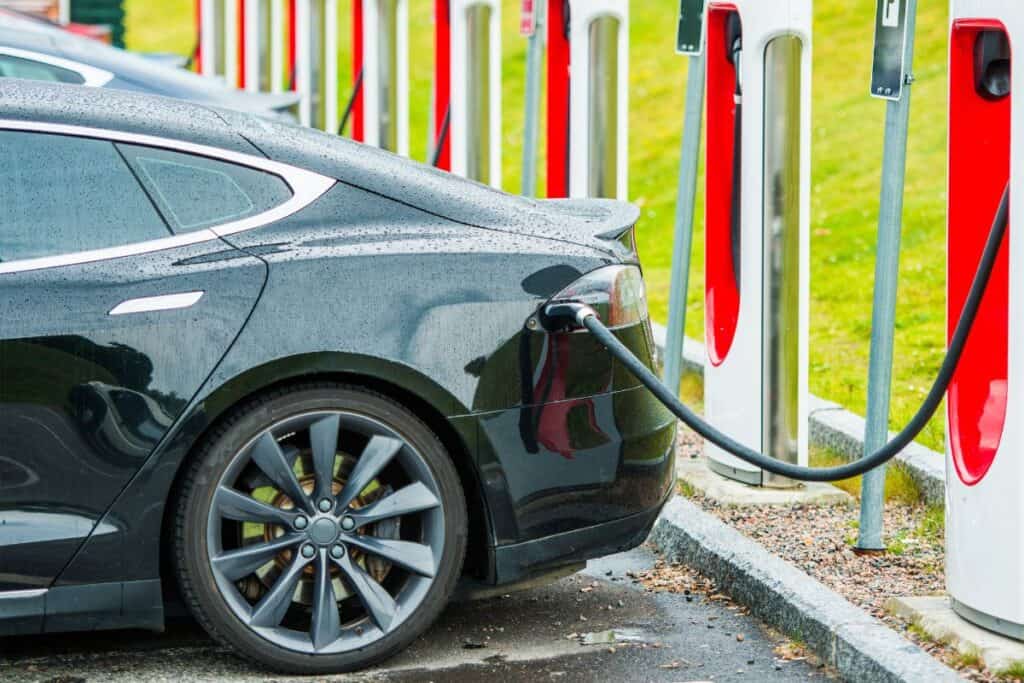
This can help you take full advantage of your solar power and significantly reduce electric vehicle charging times.
Lastly, the efficiency of the charging equipment itself can also affect how quickly your electric vehicle charges. Higher capacity chargers can charge your electric vehicle faster, but they may require a larger solar setup to provide the necessary power.
In conclusion, while solar power can be an excellent way to charge your electric vehicle, the charging time will vary depending on many factors. It’s important to work with a solar installation professional to design a system that meets your specific needs and to understand the capabilities and limitations of solar charging for your electric vehicle.
Let’s next look at whether you can charge your electric vehicle directly from solar panels or do you need a battery system.
Direct Solar Charging Versus Battery Storage System for Electric Vehicles
Charging an electric vehicle directly from solar panels is a concept that sparks the interest of many eco-conscious consumers.
The idea of using the sun’s rays to power your daily commute without a middleman sounds incredibly appealing. However, direct solar charging presents several challenges, and typically, a battery storage system is recommended.
To understand why, let’s dig into how solar energy and electric vehicle charging works. Solar panels convert sunlight into direct current (DC) electricity. This DC electricity is then converted into alternating current (AC) by an inverter, which your electric vehicle charger and other household appliances use.
Now, imagine a sunny day where your solar panels are producing electricity in real-time. Your electric vehicle is plugged in and ready to soak up the sun.
However, even on the sunniest days, solar power generation can fluctuate. For instance, a passing cloud could temporarily reduce the amount of electricity your solar panels produce. These fluctuations can potentially cause issues with your electric vehicle’s charging process.
Furthermore, this scenario presumes that you are charging your electric vehicle during daylight hours when the panels are generating power.
It’s not all sunshine & roses when it comes to charging EV’s with solar
But what if you need to charge your electric vehicle in the evening or overnight when the sun isn’t shining?
Or what if you’re generating more power than your electric vehicle needs at the moment? This is where a battery storage system becomes invaluable.
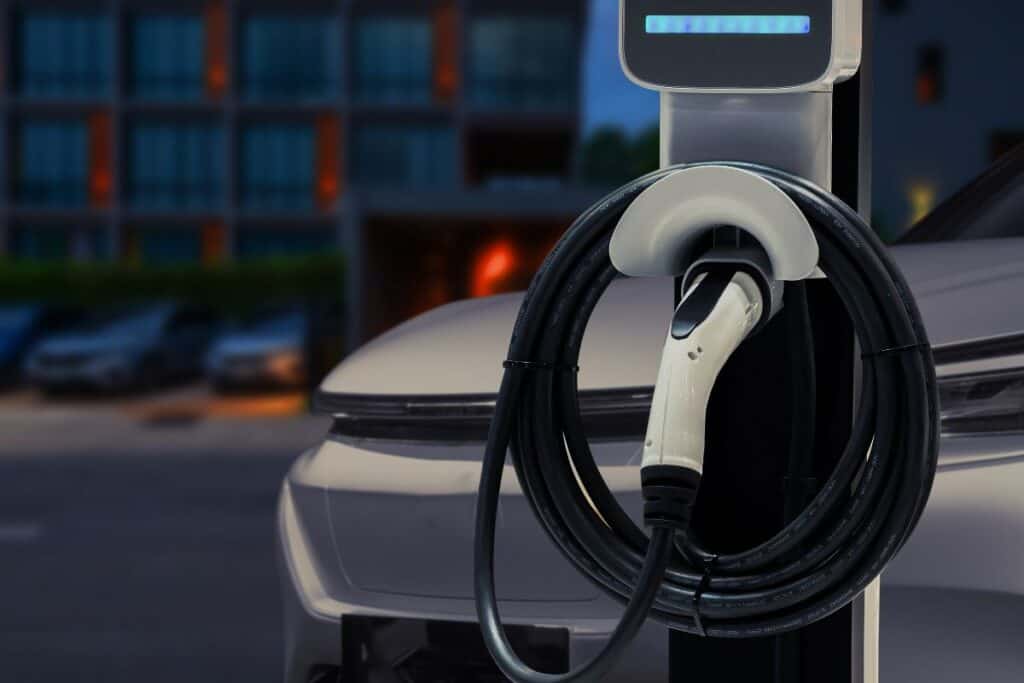
A battery system, like the Tesla Powerwall, stores the excess power generated by your solar panels.
When your panels produce more electricity than your home or electric vehicle is using, that extra energy charges the battery.
Later, when your solar panels aren’t producing electricity (like at night or during periods of heavy cloud cover), you can draw power from your battery.
It smooths out the supply and demand of electricity, allowing for a steady charge to your electric vehicle regardless of the current solar conditions.
Additionally, a battery storage system can provide backup power to your home during grid outages, adding an extra layer of security and convenience.
So while charging an electric vehicle directly from solar panels is theoretically possible, in practice it’s usually more efficient and practical to use a solar panel system paired with a battery storage system.
It enables you to charge your electric vehicle whenever needed, optimizes the use of your solar energy, and can provide backup power for your home.
When considering a solar setup for charging your electric vehicle, it’s advisable to work with a reputable solar installer to design a system that fits your specific needs and circumstances.
Essential Equipment for Charging an Electric Vehicle with Solar Power
Charging an electric vehicle (EV) using solar energy isn’t as simple as plugging your car directly into a solar panel.
To effectively and safely use solar power to charge an electric vehicle, specific equipment is required. The main components of such a system include solar panels, an inverter, a charge controller, an electric vehicle charging station, and in many cases, a battery storage system.
Solar panels are the backbone of the system, capturing sunlight and converting it into electricity. These panels can vary greatly in terms of size, efficiency, and cost, so it’s crucial to choose panels that best fit your home’s available space and your energy needs.
Next, the inverter plays a significant role by converting the direct current (DC) electricity produced by your solar panels into alternating current (AC) electricity. AC is the standard used by most household appliances and electric vehicle chargers.
An electric vehicle charge controller or regulator ensures the safe and efficient transfer of solar power to your vehicle. This device protects your battery from overcharging and extends its overall lifespan by regulating the voltage and current coming from the solar panels.
An electric vehicle charging station, sometimes known as an Electric Vehicle Supply Equipment (EVSE), is the actual point where you plug in your car.
Different types of Electric Vehicle Supply Equipment
There are different types of EVSEs with varying charging speeds.
Level 1 charging stations use a standard 120-volt AC household outlet, while Level 2 stations use a 240-volt AC circuit (like your washer or dryer), offering faster charging times.
However, not all electric vehicles can handle Level 2 charging, so you’ll need to check your vehicle’s specifications before investing in this equipment.
Finally, a battery storage system, while not absolutely necessary, can significantly enhance the functionality and convenience of your solar setup.
Solar batteries store excess energy produced by your panels for use when the panels aren’t generating electricity, like at night or during cloudy weather.
This means you can charge your electric vehicle even when the sun isn’t shining.
Installing all this equipment might seem daunting, but many solar companies now offer integrated solar and electric vehicle charging solutions, simplifying the process.
These all-in-one solutions can be an excellent choice for homeowners looking to transition to renewable energy for both their home and transportation needs.
In conclusion, to use solar power to charge an electric vehicle, you need more than just solar panels.
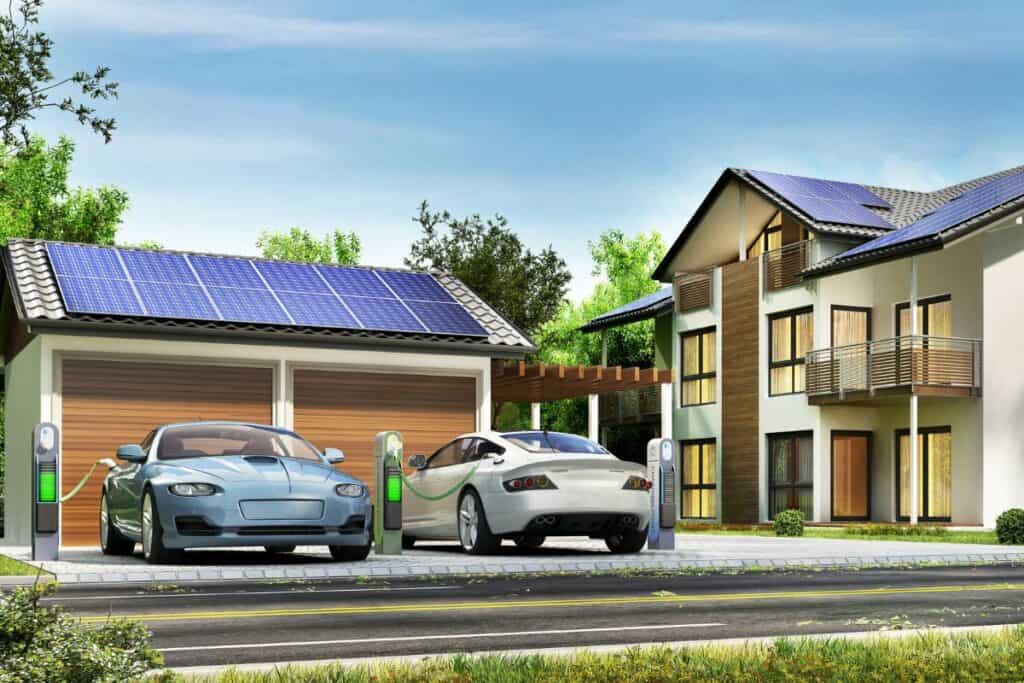
An inverter, charge controller, and electric vehicle charging station are essential pieces of equipment. Additionally, a battery storage system can optimize your solar energy usage, providing a more flexible and reliable power source for charging your electric vehicle.
Always consult with a reputable solar installer to ensure your system is tailored to your specific needs and circumstances.
Calculating the Number of Solar Panels to Charge an Electric Vehicle
The number of solar panels required to charge an electric vehicle (EV) depends on several factors. These include the efficiency of the panels, the amount of sunlight they receive, the energy consumption of the vehicle, and how frequently and far you drive.
To better understand this, let’s take a look at how these elements play into the calculation.
Firstly, it’s important to know the energy consumption of your electric vehicle. This is usually measured in kilowatt-hours per 100 miles (kWh/100mi).
For instance, a Tesla Model 3 has an efficiency of about 26 kWh/100mi. This means that for every 100 miles driven, the car consumes 26 kWh of electricity.
Secondly, consider how often and how far you drive. If you’re driving 30 miles a day, for example, you would need approximately 7.8 kWh of electricity per day (30 miles x 26 kWh/100mi = 7.8 kWh/day) to recharge your Model 3.
Next, factor in the output of your solar panels. The average solar panel produces about 1.24 kWh of electricity per day in optimal conditions (assuming 5 peak sunlight hours).
Therefore, to generate the 7.8 kWh needed daily to charge your Tesla Model 3 for your 30-mile drive, you would need approximately 7 panels (7.8 kWh ÷ 1.24 kWh/panel = 6.3 panels, rounded up to 7 for efficiency).
Factors to remember with these calculations
However, it’s important to remember that these calculations are based on optimal conditions. Realistically, factors like weather, panel orientation, shading, and degradation over time can reduce the output of your panels.
To compensate for these variables, you may need to increase the number of panels by around 25% to ensure you consistently generate enough power. So, for our example, you might actually need about 9 panels.
This is just an illustrative example. If you drive less, have a more efficient vehicle, live in a very sunny location, or if you opt for high-efficiency solar panels. The actual number of solar panels you need could be less.
Before installing solar panels to charge your electric vehicle, it’s a good idea to work with a reputable solar installer.
They can provide a detailed analysis of your specific situation. They’ll make recommendations tailored to your driving habits, local climate, and the specifics of your home and vehicle.
In conclusion, the number of solar panels needed to charge an electric vehicle varies widely based on individual circumstances.
However, with careful calculations and the right planning, solar power can indeed be a viable and sustainable way to keep your electric vehicle running smoothly.
Let’s now look at what type of solar panels are best for charging electric vehicles.
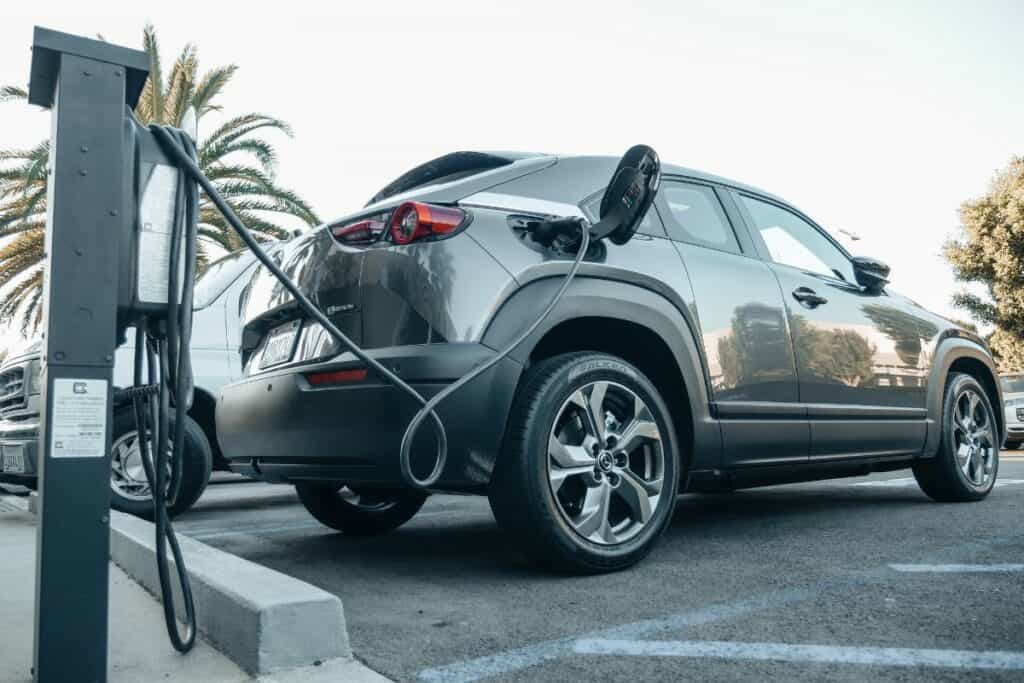
Choosing the Right Type of Solar Panels for Charging Electric Vehicles
The solar panel market is filled with various options, each with its own set of benefits and drawbacks.
If you’re planning to use solar power to charge your electric vehicle (EV), it’s crucial to choose the type of solar panel that best suits your specific needs and circumstances.
Let’s delve into some popular solar panel types and evaluate their suitability for charging electric vehicles.
Monocrystalline solar panels are known for their efficiency and aesthetics. Composed of a single crystal structure, these panels can convert more than 20% of the sun’s light into electricity. This makes them one of the most efficient types available.
Their sleek, black design is often preferred by homeowners for its visual appeal. If you have limited space for your solar system and wish to maximize power output, monocrystalline panels are a sound choice.
Polycrystalline solar panels, with their unique blueish hue, are another common type. While their efficiency rates are lower than monocrystalline panels – usually around 15-17% – they tend to be more affordable.
If budget and space are not major constraints for you, polycrystalline panels can be a practical option.
Thin-film solar panels are generally the least efficient, with conversion rates typically below 15%. However, they are lightweight, flexible, and can be manufactured in large quantities, making them the most cost-effective.
These panels might be a feasible choice if you have a large amount of space to dedicate to your solar array and are primarily concerned with initial costs.
Other factors to consider…
Aside from the types of solar panels, it’s crucial to consider other factors. The energy requirements of your electric vehicle, your local climate, and the amount of sunlight your location receives.
For instance, if your area experiences high levels of sunshine throughout the year, you might generate sufficient power with less efficient but cheaper panels.
On the other hand, if sunlight is limited, investing in high-efficiency panels like monocrystalline may be more beneficial.
In terms of charging electric vehicles specifically, the panel type alone won’t dictate your ability to charge your vehicle. The size of your solar array and the capacity of your electric vehicle’s battery will be crucial determinants.
Remember, it’s advisable to work with a solar energy expert to help you make the most informed decision.
They can analyze your unique situation and provide specific recommendations tailored to your energy needs, budget, and available space.
In summary, the “best” solar panels for charging electric vehicles depend on individual circumstances. These include energy needs, available space, budget, and local climate.
Regardless of the type chosen, transitioning to solar power for electric vehicle charging is a commendable step toward sustainable living and transport.
